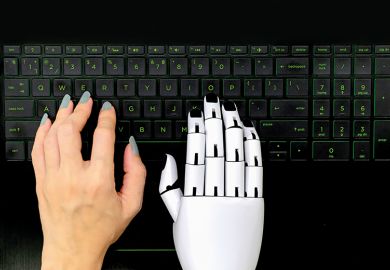Things don’t end well for the slowly boiled frog, unable to spot the danger as it turns into green soup.
The apologue feels particularly relevant in an era of climate change: we are all the frog now.
But it is also useful when considering changes such as digital transformation, a topic explored at the Digital Universities UK event held by Times Higher Education and the University of Leeds last week.
Many of the discussions were about the practical experiences of those on the front line of delivering technological transformation, and reflected the fact that change can be both gradual and sudden.
While the crunch point represented by the Covid pandemic may have seemed like the shock of being thrown into boiling water, universities’ ability to respond was down to foundations laid over time.
Reflecting on that period, Melissa Highton, director of learning, teaching and web services and assistant principal for online services at the University of Edinburgh, said: “Most of the technology that was needed [when lockdown hit] was already in place, it just needed to be scaled.”
She traced that readiness back to previous shocks, such as the volcanic eruption in Iceland – precisely 13 years ago – which created a cloud of ash that shut down travel across western Europe.
“That happened in the Easter break, which meant that all our students and staff were in the wrong place. We had to organise and look at what our VLEs [virtual learning environments] could do.”
Highton said that such incidents (another example was the Sars virus) – meant that when Covid hit, “the business continuity teams had some idea about what they would do – it then became about scaling that up and investing in the right areas”.
The lesson, she suggested, is that “universities need to pay as much attention to their digital estate as to their physical estate”, but also that universities have teams with deep technical expertise who have more than demonstrated their value.
Simon Nelson, CEO of QA Higher Education, also addressed the question of whether digital change was a slow burn or a sudden shock, reflecting on other sectors that had been hit hard in the past.
“I remember someone from the publishing industry talking to me, and he said: ‘People imagine that digital transformation is like a steady erosion, like being on an iceberg and it gradually starts to melt. My experience running a publishing company is that it’s not like that – you wake up one morning and find a quarter of the iceberg has fallen into the sea.’”
Asked whether current hype around artificial intelligence was such a moment, he added: “I don’t claim to know whether AI is the thing that causes a shelf to fall off the iceberg.
“But while I think that higher education is slower to respond than some other sectors – for lots of good reasons – I don’t think that we should obsess about amazing universities disappearing. There will always be that appetite. But there are opportunities that come with these transformations.”
Perhaps the boiled frog analogy works best when it is applied to individuals who are used to operating a certain way, and fail to adapt as the environment changes around them.
In a session on research transformation, Stuart Moran, head of digital research methods at the University of Nottingham, discussed the different paths taken by researchers.
“All researchers will need to engage with digital at a fundamental level. But then beyond that there are opportunities or options to engage, and some choose to, some choose not to.
“What I have seen is that those who do engage with digital can do more of what they do, they can do better quality, and there is a spiral of needing more digital: when they do more, they need more.
“So you have those people who engage, doing more and doing better, and then you have those who do not, and the gap between the two is going to get bigger and bigger over time.
“And there is going to become a point where the cost of entry into digital methods for those who don’t engage will be just too high, and they will be left behind.”
This ride through the issues, via pandemics and volcanoes, icebergs and frogs, is a reminder that digital transformation touches on all aspects of higher education, and has been happening for a couple of decades now.
Whether change is gradual or sudden, the key is not to be left behind: to be alive to both the threats and the opportunities, while taking care not to get caught up in hype, nor fall victim to complacency.
As Nelson concluded, no one would claim to have cracked this – it is a process, in which he suggested the best state to aim for was “informed bewilderment”.
We must hope that in the meantime, we are not undone by the development of some god-like artificial general intelligence, and turned into soup.
Register to continue
Why register?
- Registration is free and only takes a moment
- Once registered, you can read 3 articles a month
- Sign up for our newsletter
Subscribe
Or subscribe for unlimited access to:
- Unlimited access to news, views, insights & reviews
- Digital editions
- Digital access to THE’s university and college rankings analysis
Already registered or a current subscriber?



